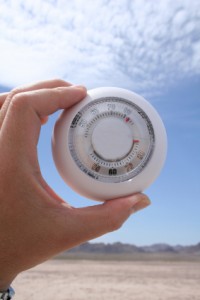 On this page, we deal with the following ways to reduce energy as you heat and cool your home:
On this page, we deal with the following ways to reduce energy as you heat and cool your home:
Click a link in the list above to jump to that topic on this page.
Thermostat
Down in winter
During the winter, turn down your thermostat a couple degrees when you aren’t home, and then again at night (it’s healthier!).
Also, turn it down a few degrees at night as you sleep. A cooler house feels healthier for sleeping anyway!
Up in summer
In summer, turn the temperature setting UP to 25°C (instead of 20°C) on your air conditioner if you are leaving your home for the day. Your home will be tolerably cool when you return and your cooling system will not have been working hard all day for no one.
Shut it off completely if you are leaving for several days.
Programmable thermostat
Installing a programmable thermostat is one of the least expensive ways to lower your home heating and cooling bill. These thermostats raise and lower the temperature automatically.
In winter, you can save 3 – 4% on your heating bill by turning your thermostat down 3°C for at least eight hours every day (1). If you also set your programmable thermostat to adjust the temperature during the day while you are away at work, you will see additional savings.
Furnace
If your furnace is more than 10 – 15 years old, it is probably a standard, 60% efficient furnace. This means that for every dollar you spend on heating, only 60 cents goes to heating your home. The other 40 cents goes right up the chimney.
Modern furnaces are 80 – 95% efficient. If you have an older furnace, replacing it with a new one will usually pay for itself in a couple of years.
Insulation
Insulation restricts the flow of heat both in and out of your home. Without insulation, even the most effective, energy-efficient heating and cooling systems will have to work hard to maintain a comfortable indoor temperature.
The following is a checklist of places in your home that should be insulated:
- Exterior walls, and walls between heated and unheated spaces (ex. attached garage)
- Floors over unheated or outside spaces
- Walls of a finished or heated basement
- Rafters and knee walls of a finished attic
- Ceilings with cold spaces above
- Perimeter of a concrete floor slab, close to grade level
- Exposed portion of foundation, or basement wall
Also see our webpage on Insulation
Sealing
All the creases, crack and holes in the average home add up to a hole one and a half feet across! (2) Simple, economic solutions like caulking and weatherstripping help slow the flow of air in and out of your home, saving you money on heating and cooling.
Windows can account for up to 25% of total heat loss from your home. (3)
Also see our webpage on Air sealing.
Storm door
A storm door will protect your main door from the worst weather that Manitoba has to offer. It is an extra layer that will also reduce heat loss from your home. Choose a model with a screened, sliding window for ventilation during the warmer seasons.
Inside your home
- Blinds and drapes – If you don’t have them, get them! Window coverings keep the heat of sun out during the summer days, lowering cooling costs. The same blinds and drapes trap heat inside during cold winter nights, keeping you warm and more energy-efficient.
- Air vents – Do not block heating and cooling duct vents with furniture or appliances. Keep vents clear for efficient, effective ventilation and climate control.
- Range fan – Use your range fan while cooking. Vent hot, moist air from cooking outside to keep your home cooler during the summer.
- Plan your day – Plan your heat and moisture generating activities around the coolest part of the day. Run the dishwasher in the evening. Iron as you watch the late-night news. Put a load of whites in the wash just before heading to bed. Reduce the heat load on your home – and cooling system – by scheduling hot activities during cooler parts of the day.
- Basement door – Keep the door to the basement closed. Even when fully finished, basements are cooler than the rest of the house. Keep the basement door closed during the winter to prevent cool air from mixing with warm air throughout the house.
- Rugs – Feet cold? Don’t touch that thermostat! Laying rugs on cold floors – in the basement, the bathroom or even an attached garage – will help to insulate and make the floor (and you) feel warmer.
Trees
Leafy trees – Plant deciduous (leafy) trees on the south side of your home for year-round savings. The trees will provide cool shade during the summer and allow sunshine through during the winter. Choose local species — they are adapted to Manitoba’s climate and require less water and maintenance.
Evergreen trees – Plant coniferous (evergreen) trees on the north side of your home. Thick evergreen trees will protect your home from cold winter winds. They also provide welcome shelter for winter birds.




